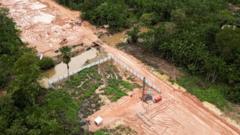The Brazilian state of Pará is witnessing the development of a new four-lane highway, a project claimed to be essential for the upcoming COP30 climate summit in Belém, where over 50,000 attendees, including world leaders, are expected to gather. While officials describe the highway, Avenida Liberdade, as a "sustainable" initiative aimed at improving traffic access, many locals and conservationists deem it a reckless endeavor that undermines the very objectives of a conference centered on climate issues.
Construction has already cleared significant areas of protected rainforest, and towering logs now mark the remnants of a thriving ecosystem that once contributed to global carbon absorption and housing diverse wildlife. Local residents, like Claudio Verequete, have seen their livelihoods destroyed; he relied on harvesting açaí berries from trees that now stand as mere memories. With no compensation from the government, he fears the road’s accessibility will encourage further deforestation for commercial developments in the area.
The ecological ramifications of the project have alarmed scientists who warn that the highway could fragment the vital ecosystem, disrupting animal movements and threatening biodiversity. Dr. Silvia Sardinha, a wildlife researcher, notes that the loss of natural habitats adversely affects wildlife rehabilitation efforts and stresses the need for open ecosystems for species to thrive.
Despite promises from Brazilian officials of wildlife crossings and bike lanes integrated into the highway design, many believe such measures are inadequate to mitigate the construction's broader impacts. This discourse raises critical questions about who benefits from the developments associated with the summit—whether improvements are truly in the interest of the local population or merely serve corporate and political agendas.
Additionally, the state government has initiated a range of infrastructure projects in preparation for the summit, including enhancements to the airport and city parks. While some business owners acknowledge the potential economic benefits, they also express hope that the summit discussions lead to actionable change rather than just rhetoric.
As scrutiny intensifies over the implications of handling climate discussions amid such destructive practices, the road to progress appears fraught with contradictions, questioning the priorities of those who claim to advocate for the planet's wellbeing. With world leaders set to arrive, the urgency to balance development with sustainability has never been clearer, leaving both local residents and environmentalists wary of the true legacy COP30 will leave behind.
Construction has already cleared significant areas of protected rainforest, and towering logs now mark the remnants of a thriving ecosystem that once contributed to global carbon absorption and housing diverse wildlife. Local residents, like Claudio Verequete, have seen their livelihoods destroyed; he relied on harvesting açaí berries from trees that now stand as mere memories. With no compensation from the government, he fears the road’s accessibility will encourage further deforestation for commercial developments in the area.
The ecological ramifications of the project have alarmed scientists who warn that the highway could fragment the vital ecosystem, disrupting animal movements and threatening biodiversity. Dr. Silvia Sardinha, a wildlife researcher, notes that the loss of natural habitats adversely affects wildlife rehabilitation efforts and stresses the need for open ecosystems for species to thrive.
Despite promises from Brazilian officials of wildlife crossings and bike lanes integrated into the highway design, many believe such measures are inadequate to mitigate the construction's broader impacts. This discourse raises critical questions about who benefits from the developments associated with the summit—whether improvements are truly in the interest of the local population or merely serve corporate and political agendas.
Additionally, the state government has initiated a range of infrastructure projects in preparation for the summit, including enhancements to the airport and city parks. While some business owners acknowledge the potential economic benefits, they also express hope that the summit discussions lead to actionable change rather than just rhetoric.
As scrutiny intensifies over the implications of handling climate discussions amid such destructive practices, the road to progress appears fraught with contradictions, questioning the priorities of those who claim to advocate for the planet's wellbeing. With world leaders set to arrive, the urgency to balance development with sustainability has never been clearer, leaving both local residents and environmentalists wary of the true legacy COP30 will leave behind.

















